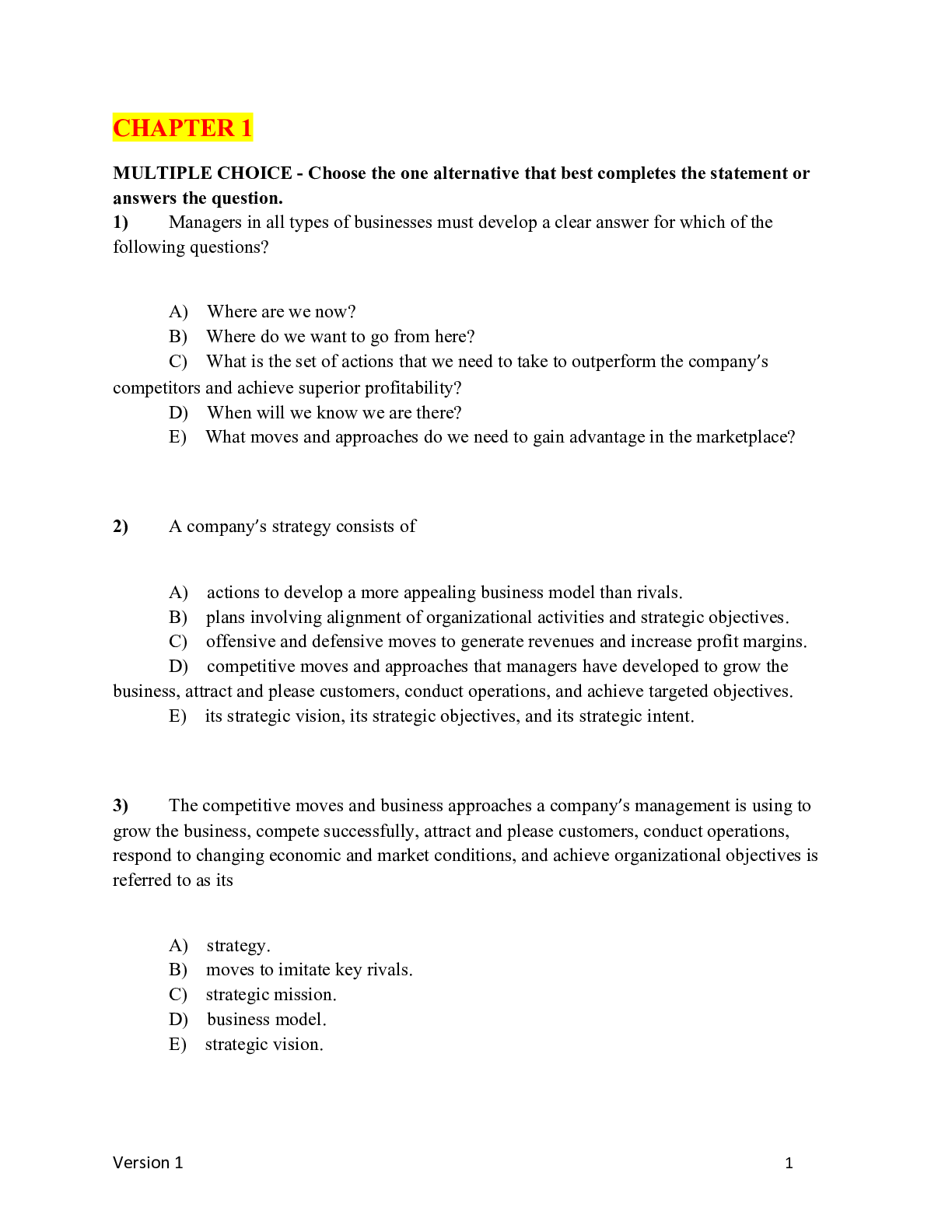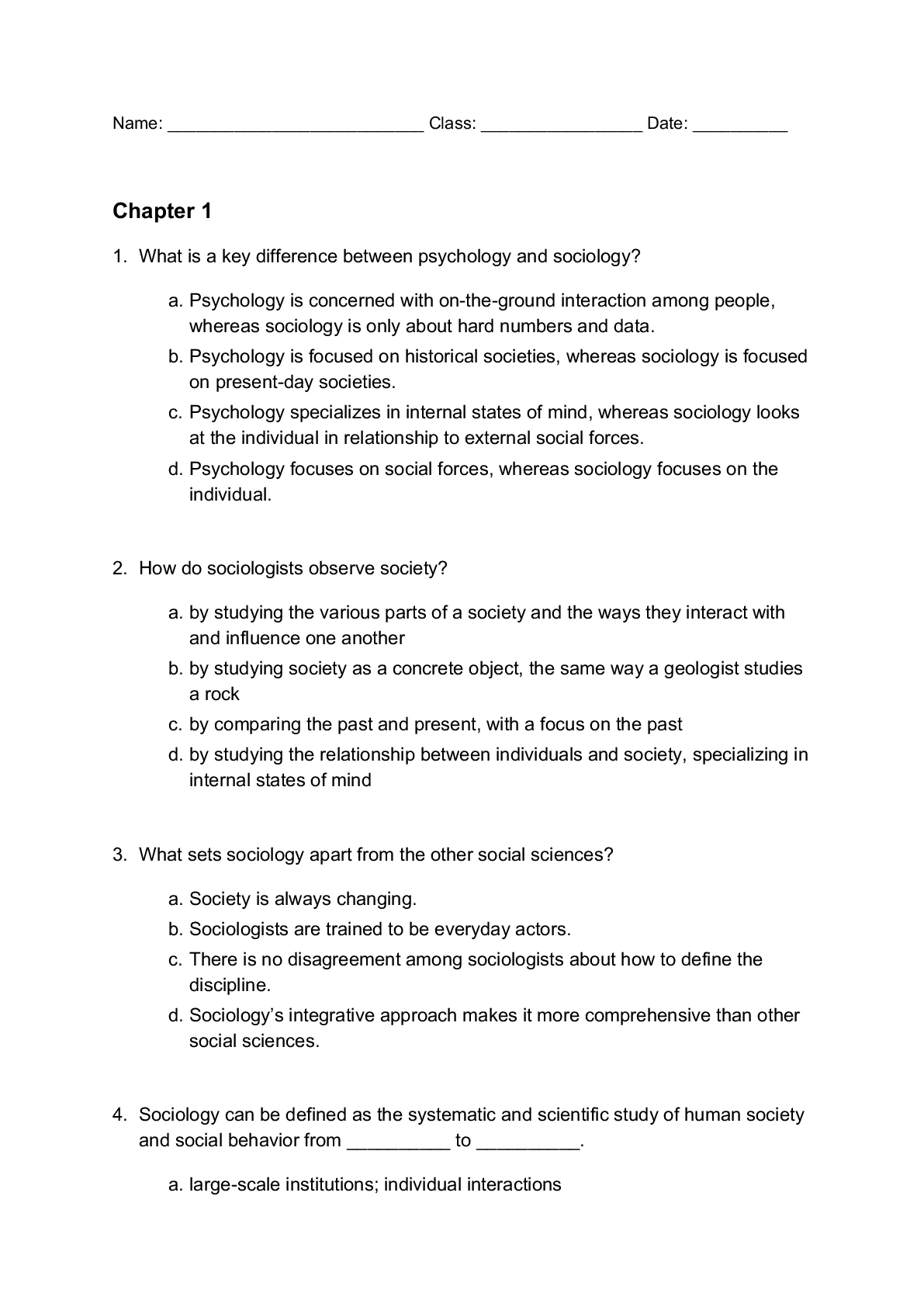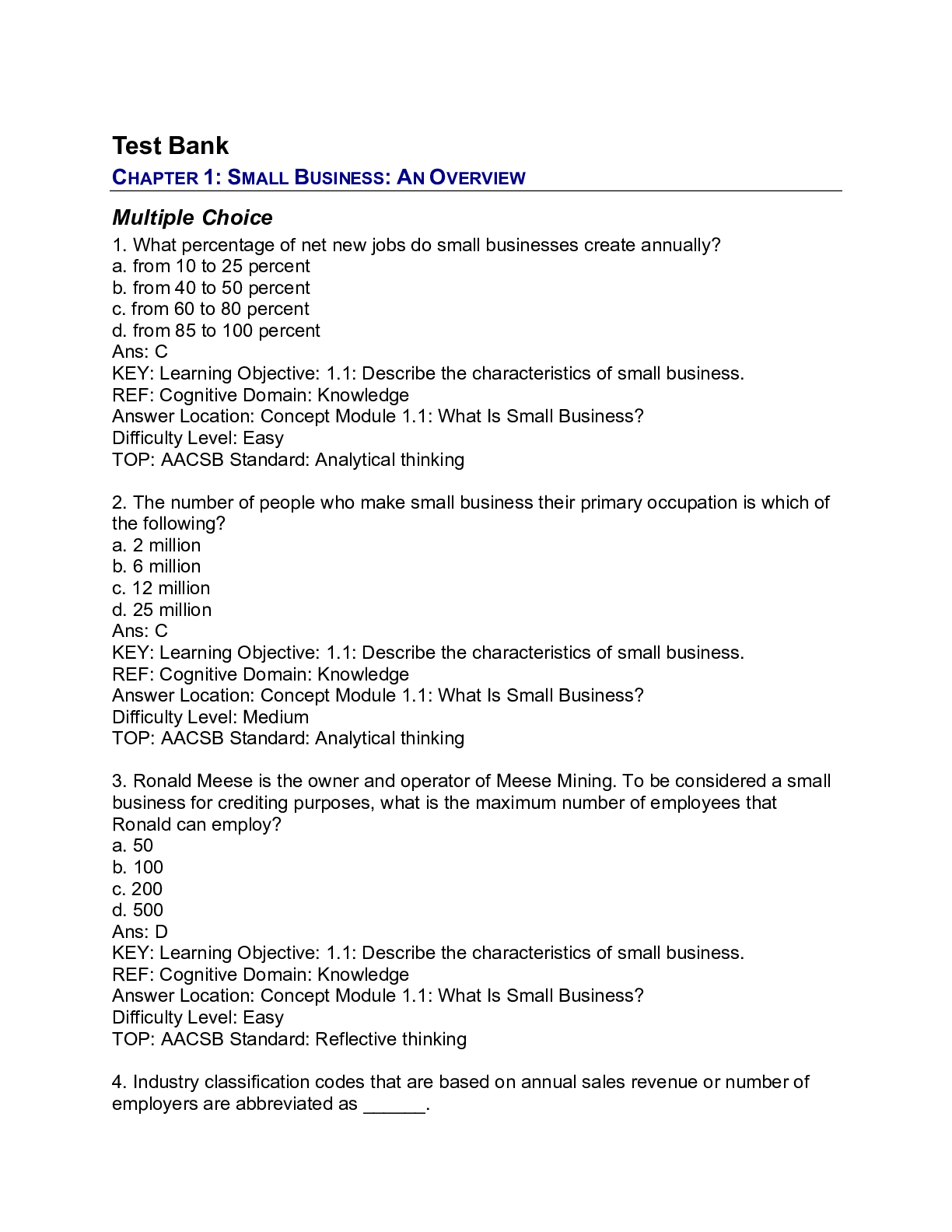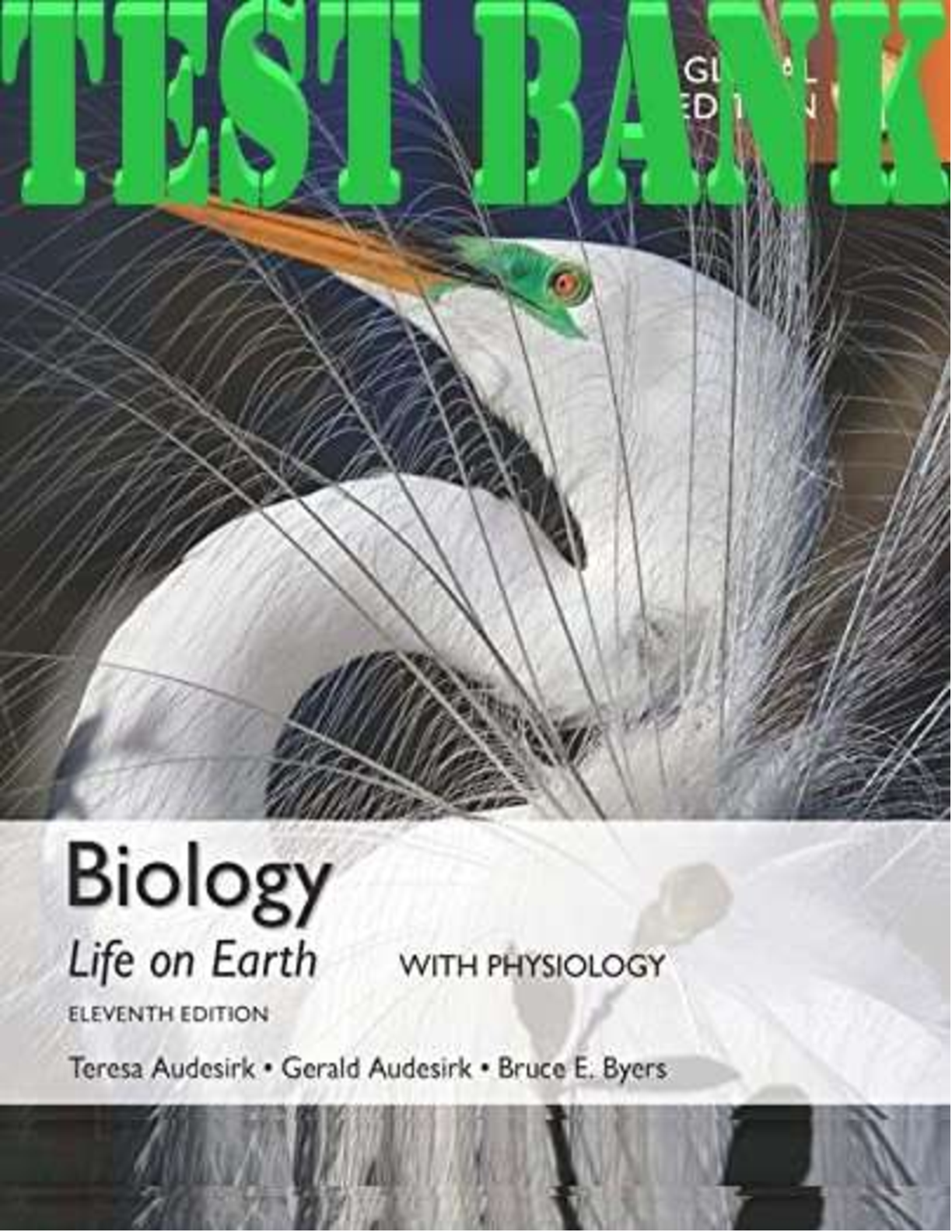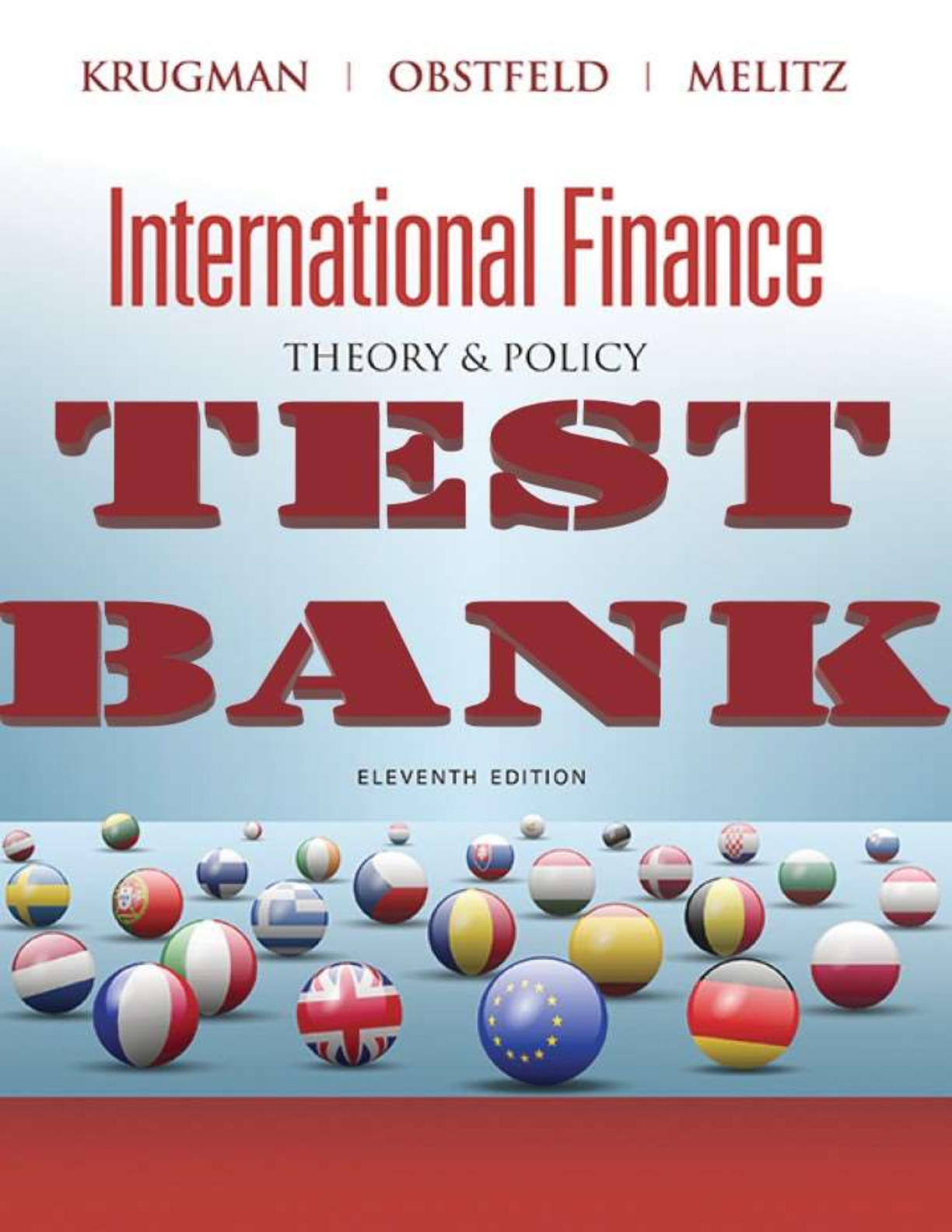Biology > TEST BANKS > TEST BANK for Animal Behavior, 11th Edition by Dustin Rubenstein and John Alcock (All)
TEST BANK for Animal Behavior, 11th Edition by Dustin Rubenstein and John Alcock
Document Content and Description Below
Test Bank for Animal Behavior, 11th Edition, 11e by Dustin Rubenstein, John Alcock TEST BANK ISBN-13: 9781605355481 Full chapters included CHAPTER 1: An Introduction to Animal Behavior Natural S... election and the Evolution of Behavior The Cost–Benefit Approach to Behavioral Biology The Levels of Analysis BOX 1.1 Natural selection and infanticide in primates The Integrative Study of Animal Behavior Approaches to Studying Behavior The Adaptive Basis of Behavior: Mobbing in Gulls BOX 1.2 Phylogenies and the comparative method BOX 1.3 The benefit of high nest density for the arctic skua The Science of Animal Behavior CHAPTER 2: The Integrative Study of Behavior The Development of Song Learning BOX 2.1 Characterizing sounds made by animals Intraspecific Variation and Dialects Social Experience and Song Development Mechanisms of Song Learning BOX 2.2 Song learning in birds adoptedby another species The Genetics of Song Learning Control of the Avian Song System BOX 2.3 Proximate mechanisms underlying song preferences in females The Evolution of Song Learning An Evolutionary History of Bird Song Mechanisms of Song Learning and the Comparative Approach Human versus Avian Vocal Learning The Adaptive Value of Song Learning BOX 2.4 Why might song learning make males communicate more effectively with rivals or potential mat Adapting to the Local Environment Recognition: Friends versus Foes Sexual Selection: Male–Male Competition Sexual Selection: Female Choice and Assortative Mating The Integrative Study of Bird Song CHAPTER 3: The Developmental and Genetic Bases of Behavior Behavior Requires Genes and the Environment The Interactive Theory of Development BOX 3.1 Behavioral genetics: Identifying the genetic basis of differences in behavior Environmental Differences Can Cause Behavioral Differences Genetic Differences Can Also Cause Behavioral Differences BOX 3.2 Migratory restlessness Learning and Cognition Learning Requires Both Genes and Environment Learning in Complex Environments The Adaptive Value of Learning The Evolutionary Development of Behavior The Evo-Devo Approach to Understanding Behavior BOX 3.3 The genetics of foraging behavior in honey bees Early Life Developmental Conditions The Role of the Social Environment Developmental Homeostasis versus Developmental Constraint Developmental Switch Mechanisms Supergenes and Behavioral Polymorphisms CHAPTER 4: The Neural Basis of Behavior Responding to Stimuli Complex Responses to Simple Stimuli How Moths Avoid Bats BOX 4.1 Ultrasound detection in the moth ear Ultrasonic Hearing in Other Insects Neural Command and Control Decision Making in the Brain From Ultrasound to Ultraviolet Radiation Selective Relaying of Sensory Inputs Responding to Relayed Messages The Proximate Basis of Stimulus Filtering BOX 4.2 Determining how female parasitoid wasps choose their singing male bush-cricket hosts BOX 4.3 Cortical magnification in mammals The Evolution of Cognitive Skills Box 4.4 Do energetic demands explain why humans have such large brains? CHAPTER 5: The Physiological Basis of Behavior Endogenous Rhythms and Changing Behavioral Priorities Mechanisms of Changing Behavioral Priorities The Neurobiology of Circadian Timing The Genetics of Circadian Timing The Physiology of Circadian Timing Seasonal and Annual Cycles of Behavior Cues That Entrain Cycles of Behavior Predictable Environmental Cues BOX 5.1 Hormonal responses to light in birds Unpredictable Environmental Cues Social Conditions and Changing Priorities Hormonal Mechanisms Underlying Behavioral Change Organizational versus Activational Effects of Hormones on Behavior and Development BOX 5.2 Measuring hormones in animals BOX 5.3 Do steroid hormones modulate male parental behavior in California mice? Hormones and Reproduction Testosterone and Reproductive Behavior The Costs of Hormonal Regulation Glucocorticoids and Responding to Environmental Change CHAPTER 6: Avoiding Predators and Finding Food Avoiding Predators Social Defenses BOX 6.1 Evolutionary game theory Game Theory and Social Defenses Box 6.2 Game theory and the selfish herd Blending In Standing Out Optimality Theory and Antipredator Behavior Finding Food Optimality Theory and Foraging Decisions BOX 6.3 Territoriality and feeding behavior in golden-winged sunbirds BOX 6.4 Optimal foraging by pike cichlid fish Criticisms of Optimal Foraging Theory Landscapes of Fear Game Theory and Feeding Behavior CHAPTER 7: Territoriality and Migration Where to Live Habitat Selection Territoriality and Resource-Holding Potential BOX 7.1 How to track migratory songbirds Why Give Up Quickly When Fighting for a Territory? The Dear Enemy Effect To Stay or Go Dispersal BOX 7.2 Opposite patterns of sexbiased dispersal in mammals and birds Migration The Costs and Benefits of Migration BOX 7.3 Behaviors to reduce the costs of flying during migration Variation in Migratory Behavior Box 7.4 Migratory pathways of Swainson’s thrush CHAPTER 8: Principles of Communication Communication and Animal Signals Information Use and Animal Signals The Evolution of Animal Signals Preexisting Traits and the Development of a Strange Display The Panda Principle and Preexisting Traits Preexisting Biases and the Evolution of Animal Signals BOX 8.1 Spiders hunting prey at night Preexisting Traits versus Preexisting Biases BOX 8.2 Why do female moths mate with males that produce ultrasonic mimetic signals similar to those The Function of Animal Signals The Adaptive Function of a Strange Display Honest Communication and Threat Displays Honest Signaling BOX 8.3 Mechanisms and measurement of animal coloration When Multiple Honest Signals Are Better Than One Deceitful Signaling Eavesdropping on Others CHAPTER 9: Reproductive Behavior Sexual Selection and the Evolution of Sex Differences Sex Differences in Reproductive Behavior BOX 9.1 Are sperm always cheap? Sex Differences and Parental Investment A Reversal in Sex Differences Intrasexual Selection and Competition for Mates Competition and Access to Mates Coexistence of Conditional Mating Tactics Coexistence of Alternative Mating Strategies Sperm Competition Mate Guarding and Paternity Assurance Intersexual Selection and Mate Choice Female Mate Choice for Direct Benefits Female Mate Choice for Indirect Benefits BOX 9.2 Sexual selection in the peacock Runaway versus Chase-away Sexual Selection Cryptic Female Choice Sexual Conflict The Manipulation of Female Choice Sexual Arms Races CHAPTER 10: Mating Systems Monogamy: A Lack of Multiple Mating Why Be Monogamous? Monogamy in Species with Paternal Care Monogamy When Paternal Care Is Rare Polyandry: Multiple Mating by Females Monogamous Males and Polyandrous Females BOX 10.1 Sexual parasitism, dwarf males, and the evolution of gigolos Polyandry and Indirect Genetic Benefits BOX 10.2 Extra-pair paternity and good genes in birds Polyandry and Direct Benefits Polygyny: Multiple Mating by Males Female Defense Polygyny Resource Defense Polygyny Lek Polygyny Scramble Competition Polygyny BOX 10.3 Lekking females in a sexrole reversed pipefish Polygynandry and Promiscuity: Multiple Mating by Both Sexes Polygynandry Promiscuity CHAPTER 11: Parental Care Offspring Value and Parental Investment Parental Care Decisions Parental Favoritism in Offspring Care and Production Parental Favoritism in Humans Family Conflict To Care or Not to Care The Costs and Benefits of Parental Care Sexual Conflict and Parental Care: Who Cares? BOX 11.1 Why do females provide all of the care in treehoppers? Why Do Females Care? Why Do Males Care? BOX 11.2 Reactions of nestdefending bluegill males to potential egg and fry predators under two cond Discriminating Parental Care Recognizing One’s Own Offspring BOX 11.3 Why do parents in some species adopt genetic strangers of their own species? Interspecific Brood Parasitism Choosing the Correct Host Coevolutionary Arms Races The Evolution of Interspecific Brood Parasitism CHAPTER 12: Principles of Social Evolution BOX 12.1 The major evolutionary transitions Altruism and the Levels of Selection Individual versus Group Selection Altruism and the Role of Kin Selection BOX 12.2 Calculating genetic relatedness Kin Selection and Inclusive Fitness Theory Challenges to Kin Selection and Inclusive Fitness Theory BOX 12.3 Altruism in amoebae Haplodiploidy and the Evolution of Eusociality Testing the Haplodiploidy Hypothesis Inclusive Fitness and Monogamy in Eusocial Insects BOX 12.4 Division of labor in clonal trematode flatworms Sterility and Caste Differentiation Social Conflict in Animal Societies Reproductive Conflict CHAPTER 13: Social Behavior and Sociality The Evolution of Social Behavior Forms of Social Behavior Mutual Benefit BOX 13.1 How do groups of animals decide where to go? BOX 13.2 Social network analysis Altruism and Reciprocity Non-cooperative Social Behaviors: Selfishness and Spite Individual Differences in Social Behavior Personalities in Social Species The Evolution of Cooperative Breeding Reproductive Cooperation and Kin Selection Reproductive Benefits and Cooperative Breeding BOX 13.3 Mobbing and kinship in groups of Siberian jays Reproductive Costs and Cooperative Breeding Reproductive Conflict in Cooperative Breeders Reproductive Suppression Reproductive Skew, Extrapair Paternity, and Social Structure BOX 13.4 Why do males and females both have elaborate traits in social species? CHAPTER 14: Human Behavior Communication The Development and Evolutionary History of Human Speech BOX 14.1 Ethical studies of humans and other animals The Neurophysiology of Speech The Adaptive Value of Speech Reproductive Behavior An Evolutionary Analysis of Human Mate Choice Mate Choice by Women BOX 14.2 Female choice and the features of dominant versus attractive men BOX 14.3 Human mate choice in an online world Mate Choice by Men Reproductive and Sexual Conflict in Humans Extreme Sexual Conflict in Humans: Polygamy and Extramarital Affairs Coercive Sex Practical Applications of Behavioral Theory Evolutionary Medicine The Triumph of an Evolutionary Analysis of Human Behavior [Show More]
Last updated: 7 months ago
Preview 6 out of 61 pages

Loading document previews ...
Buy this document to get the full access instantly
Instant Download Access after purchase
Buy NowInstant download
We Accept:

Reviews( 0 )
$24.00
Can't find what you want? Try our AI powered Search
Document information
Connected school, study & course
About the document
Uploaded On
Aug 16, 2022
Number of pages
61
Written in
Additional information
This document has been written for:
Uploaded
Aug 16, 2022
Downloads
0
Views
173





